The global labour market faces the critical challenge of balancing the availability of skilled workers with the demands of evolving job markets. This paradoxical situation manifests as the co-existence of unemployment rates and a high demand for skilled labour, leaving employers grappling with talent shortages. Addressing this talent gap has become a pressing concern, as it not only hampers economic growth but also perpetuates a cycle of unfulfilled potential and stagnant productivity.
Key challenges and opportunities
Surging demand vs skill shortages
The critical challenge fueling this paradox lies in the surging demand for skilled labour that has outpaced the supply of qualified workers. Economic development and the advent of new technologies have created a surge in demand for skilled labour, particularly in new and evolving roles. However, this demand is met with a significant gap between job requirements and the skills possessed by workers, which drives the need for skilled labour across various sectors.
High demand for technical and vocational jobs
Compounding this issue is the pronounced demand for technical/vocational jobs in fields experiencing alarmingly high skill shortages despite high unemployment rates like information technology and cybersecurity. These roles often require specialised knowledge and hands-on expertise that traditional educational programs may not adequately provide.
Also read: Keeping them Engaged by Dr. Deepak Malhotra
Global shortages of skilled workers
The global nature of this talent crunch is particularly concerning, with the shortage of skilled workers being most pronounced in field-based roles (like construction, healthcare, manufacturing, etc.). Due to a lack of qualified candidates, millions of jobs remain unfilled in major economic regions like Europe and the United States. This widespread dearth of skilled talent has far-reaching implications, posing a significant threat to economic growth and competitiveness on a global scale.
Education and industry collaboration
There is a dire need for a robust collaborative approach between industry stakeholders and educational institutions. The association will help ensure students are thoroughly prepared for the workforce according to industry standards. So, schools and vocational institutions should revise their curriculums to integrate practical skills along with theoretical knowledge to help students stand out in the competitive workforce.
Government role in skill development
The Government’s role is pivotal in ensuring a long-term culture for skill development and lifelong learning. Students can benefit from Government-backed vocational and technical education solidified by funding initiatives and vital policies. This way, the Government can significantly contribute to building a more resilient and robust workforce. For instance, the UAE government’s ‘National Program for Advanced Skills imparts both soft and technical skills to its citizens (K–12 students, graduates with at least 15 years of experience, and workers with over 15 years of experience). Similarly, in India, the Pradhan Mantri Kaushal Vikas Yojana (PMKVY) Skill India Campaign etc has taken the lead in skill development.
Private sector initiatives
The private sector’s involvement in bridging the talent gap is undeniable. Companies in the private sector must introduce more education and training programs as well as internship opportunities with a core focus on skill-based hiring practices. They can collaborate with educational institutions to shape curriculum and ensure adequate skilled talent by investing in skilling and reskilling initiatives.
Revamp vocational training
Navigating the talent crunch demands more vocational training programs that combine practical and soft skills training (like problem-solving exercises, interpersonal skills development, and hands-on training). These programs help enhance students’ skills and prepare them to face the competitive modern workplaces.
Also read: Ratna Joshi joins Mahindra and Mahindra as Senior General Manager – HR
Enhance higher education
Colleges and universities must incorporate work-based skills into their programs from the first year. Professional skills training must also be offered to students throughout their educational journey. With this approach, institutions can instill practical skills and a mindset to thrive in the modern workforce supported by theoretical knowledge.
Leverage technology and data
SaaS-based migrant blue-collar worker marketplaces serve as intermediaries by bringing together training providers and clients to conduct impactful training sessions. They help provide trainers with client-supplied materials and data points, further supporting managing the pipeline of trained workers and providing tailor-made training focused on skilling, reskilling, and upskilling.
Build robust partnerships
These SaaS-based migrant blue-collar worker platforms promote associations among colleges, governments, and industries and ensure the delivery of tailored programs that align with the dynamic needs of the job market. These collaborations are integral in bridging the gap between education and employment requirements for a more skilled and adaptable workforce.
Overcoming the global talent crunch clearly requires a collaborative and concerted effort from all stakeholders, ranging from governments, private enterprises, educational institutions, and individuals alike. As we look forward, the ability to adapt and continuously develop new skills will be paramount. Embracing a mindset of lifelong learning and maintaining an environment that supports skill development will be critical to ensure that the workforce remains agile and responsive to the changing demands of the global job market. Only in this way, the full potential of human capital can be unlocked, paving the way for sustainable economic growth and prosperity in an increasingly connected world.
Stay connected with us on social media platforms for instant updates click here to join our LinkedIn, Twitter & Facebook
























